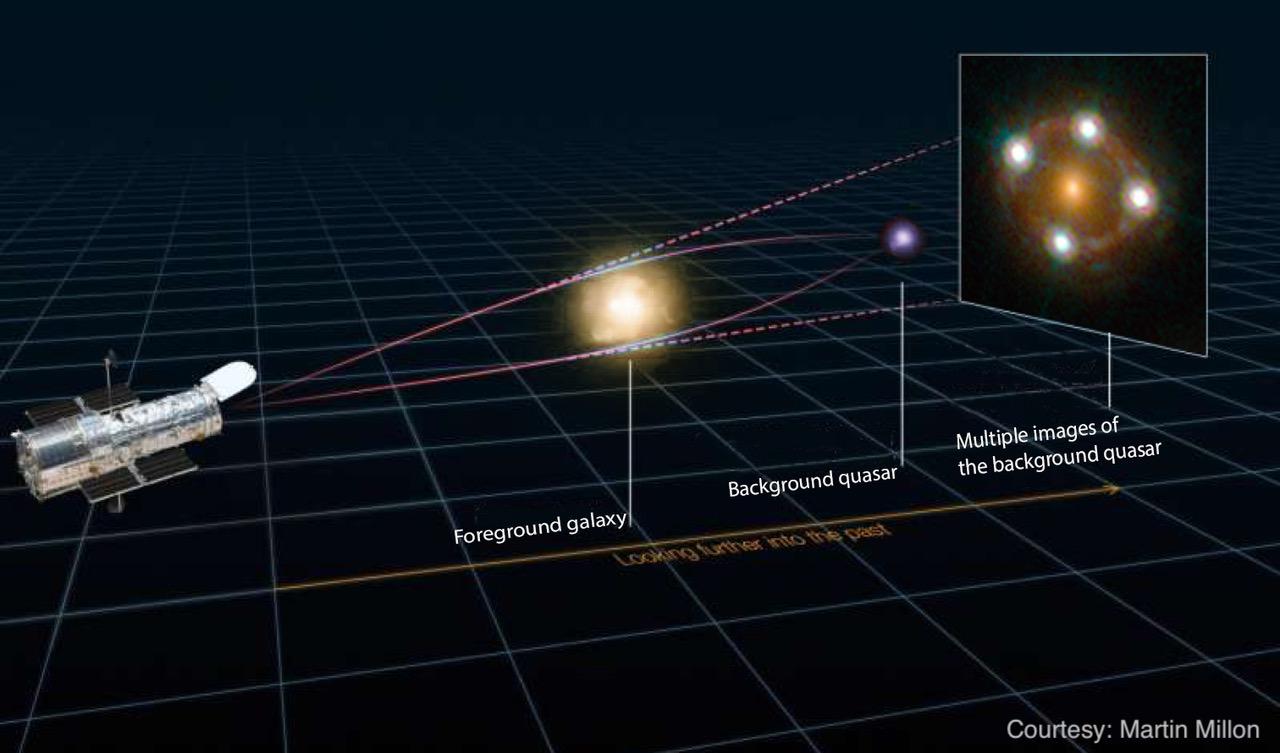Cosmic magnifying glasses show faster expanding universe

© Hubble, ESA & NASA
New measurements using gravitational lensing, an innovative method that EPFL researchers have been working on for many years, suggest the universe is expanding faster than previously thought.
A team of astronomers using NASA’s Hubble Space Telescope have announced that the universe is expanding faster than expected. They measured the expansion rate – called the Hubble constant, or H0, – using gravitational lensing, a brand-new technique, completely independent of any previous method, that EPFL’s Laboratory of Astrophysics (LASTRO) has been working on for many years.
The study was led by a group called H0 Lenses in COSMOGRAIL’s Wellspring, or H0LiCOW. COSMOGRAIL, which stands for COsmological MOnitoring of GRAvItational Lenses, is a large international project initiated by EPFL astrophysicists to monitor gravitational lenses. It represents the most precise measurement yet using the gravitational lensing method, where the gravity of a foreground galaxy acts like a giant magnifying lens, amplifying and distorting light from background objects.
The results suggest a faster expansion rate in the local universe than expected. The researchers calculated a Hubble constant value of 73 kilometers per second per megaparsec (with 2.4% uncertainty). This means that for every additional 3.3 million light-years away a galaxy is from Earth, it appears to be moving 73 kilometers per second faster, because of the universe’s expansion. This value differs significantly from the previous number of 67, which was based on observations by the European Space Agency’s Planck satellite on how the cosmos behaved more than 13 billion years ago.
This troubling discrepancy between the two values – the expansion rate calculated from gravitational lensing measurements of the local universe, and the rate as conventionally predicted from background radiation in the early universe – has caused turmoil in the astrophysics community. This is because knowing the precise value for how fast the universe expands is important for determining the age, size and fate of the cosmos. Unraveling this mystery has been one of the greatest challenges in astrophysics in recent years.
“If these results do not agree, it may be a hint that we do not yet fully understand how matter and energy evolved over time, particularly at early times,” said H0LiCOW team leader Sherry Suyu of the Max Planck Institute for Astrophysics in Germany.
Six faraway quasars
The H0LiCOW team used Hubble to observe the light from six faraway quasars, the brilliant searchlights from gas orbiting supermassive black holes at the centers of galaxies. Quasars are ideal background objects for many reasons; for example, they are bright, extremely distant, and scattered all over the sky. The telescope observed how the light from each quasar was multiplied into four images by the gravity of a massive foreground galaxy.

The light rays from each lensed quasar image take a slightly different path through space to reach Earth. The pathway’s length depends on the amount of matter that is distorting space along the line of sight to the quasar. To trace each pathway, the astronomers monitor the flickering of the quasar’s light as its black hole gobbles up material. When the light flickers, each lensed image brightens at a different time.
This flickering sequence allows researchers to measure the time delays between each image as the lensed light travels along its path to Earth. To fully understand these delays, the team first used Hubble to make accurate maps of the distribution of matter in each lensing galaxy. Astronomers could then reliably deduce the distances from the galaxy to the quasar, and from Earth to the galaxy and to the background quasar. By comparing these distance values, the researchers measured the universe’s expansion rate.
“The length of each time delay indicates how fast the universe is expanding,” said team member Kenneth Wong of the University of Tokyo’s Kavli Institute for the Physics and Mathematics of the Universe. “If the time delays are shorter, then the universe is expanding at a faster rate. If they are longer, then the expansion rate is slower.”
Observing 40 lensed systems
“One of the challenges we overcame was having dedicated monitoring programs through COSMOGRAIL to get time delays for several of these quasar lensing systems,” said Frédéric Courbin, a researcher in EPFL’s LASTRO lab, and the founder and leader of COSMOGRAIL.
“New mass modeling techniques were developed to measure a galaxy’s matter distribution, including models we designed to make use of the high-resolution Hubble imaging,” added Suyu. “The images enabled us to reconstruct, for example, the quasars’ host galaxies and to characterize the environment of the lens system, which affects the bending of light rays. The new mass modeling techniques, in combination with the time delays, help us to measure precise distances to the galaxies.”
Begun in 2012, the H0LiCOW team now has Hubble images and time-delay information for ten lensed quasars and intervening lensing galaxies. The team’s goal is to observe 30 more lensed quasar systems to reduce their 2.4% percent uncertainty to 1%.
Contact:
EPFL:
Frédéric Courbin, EPFL Astrophysics Laboratory, [email protected], +41 22 379 24 18
Martin Millon, EPFL Astrophysics Laboratory, [email protected], +41 22 379 24 39
NASA:
Donna Weaver, Space Telescope Science Institute, Baltimore, Maryland, [email protected], +001 410-338-4493
Ray Villard, Space Telescope Science Institute, Baltimore, Maryland, [email protected], +001 410-338-4514